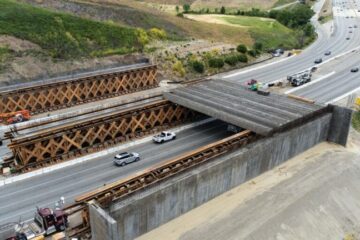50-Year, $626-Million Renewal Project for Colorado River
A $626-million program will restore wildlife and habitat to the lower Colorado. But some conservationists call it mere window dressing.
Source of this article – Los Angeles Times, April 3, 2005.

Habitat enhancement: The Lower Colorado River Multi-Species Conservation Program Is designed to improve the wildlife habitat along some stretches of the river between Lake Mead and the Mexican border. Endangered native fish will be stocked in the river. Cottonwoods, willows and mesquite will be planted for birds and other wildlife.
By BETTINA BOXALL, Times Staff Writer
Interior Secretary Gale Norton will launch a half-century effort Monday to return native trees, fish and wildlife to a lower Colorado River system profoundly altered by man’s thirst.
Environmental groups are skeptical, however, that the transformation can stick without fundamental changes in the river’s flow.
By the time the mythic Colorado of Western imagination flows past the baking scrub and farmland of California’s south-eastern comer, it has been tamed and used many times over and is known more for its fatal speedboat accidents than for its natural splendor.
But the beleaguered native fish and wildlife of the lower Colorado will get help when Norton signs final documents adopting a 50-year, $626-million program to offset some of the environmental damage done by dams and pumping that supply river water to millions of residents of Southern California, Nevada and Arizona.
About 8,130 acres of habitat will be created and maintained along portions of a 400-mile leg of the Colorado running from Lake Mead to the Mexican border.
Native endangered fish will be reared in hatcheries and ponds and then stocked in the river. Cottonwoods, willows and mesquite will be planted along the banks to provide migrating birds with nesting and feeding grounds. Backwater pools and marshes will be enhanced.
Federal officials and water managers say no other project in the West has attempted habitat improvements along so extensive a river course.
“It’s a major, major accomplishment,” said Dennis B. Underwood, who on Friday was promoted to chief executive officer and general manager of the Metropolitan Water District of Southern California, which is picking up $88 million of the project’s tab.
But conservationists condemn the effort, saying it is little more than extravagant window dressing that does nothing to restore the lower Colorado’s shattered natural rhythms.
“It’s certainly expensive, but I’m just not sure they’re getting very good returns on their investment,” said Jennifer Pitt of Environmental Defense. “Their intention is to raise native fish in a hatchery and every year dump them in the river with no expectation that they have done anything to make the river a viable habitat.”
Glen Canyon and Hoover, the Colorado’s two big dams, didn’t just create huge reservoirs, they radically altered the river’s character. Instead of a warm, muddy current that swung to extremes, flooding with snowmelt in the spring and shrinking to stream size in late summer, the Colorado runs steady, cold and clear, playing havoc with fish and plants that over millions of years had adapted to a turbulent environment.
Farmers chopped down the native cottonwood and willow groves to plant crops. Engineers forced the river into channels to make sure it behaved itself. Government agencies stocked the river with sport fish that feasted on the unglamorous native species.
All that has resulted in the collapse of native wildlife populations. The once abundant bonytail, humpback chub and razorback sucker flsh are on the endangered species list. Only 5% of the lower river corridor’s cottonwood-willow groves are left. The Southwestern willow flycatcher also is endangered, along with the Yuma clapper rail.
In 1997 the U.S. Fish and Wildlife Service ruled that the U.S. Bureau of Reclamation’s dam and water diversion operations on the Colorado threatened the existence of the flycatcher, bonytail and sucker, requiring the bureau to take action to offset the environmental harm. That prompted development of the conservation plan Norton is to sign at a ceremony at Hoover Dam.
By improving habitat for 26 species, many of them birds, the program is designed to keep reclamation and regional water agencies from running afoul of environmental laws that could interfere with, or even shut down, their operations.
The federal government will pay half the $626-million cost of the program, with water users in California, Nevada and Arizona paying the rest.
The price tag includes flsh stocking, purchase of private land to convert to cottonwood groves and purchase of water to irrigate the groves. Without nature’s floods, the trees will need watering, which will also create moist conditions favored by insects the birds can eat.
“It’s kind of like the Disneyland version,” complained Pitt.
Instead of creating habitat that has to be artificially maintained, Environmental Defense and other groups urged reclamation to modify its dam operations to periodically mimic nature, creating small controlled floods.
But water managers rejected that approach as impractical.
Federal biologists say wildlife will be better off under the program than under existing conditions.
“I think the [project] is going to establish this acreage of restored riparian habitat that isn’t available today,” said Sam Spiller, lower Colorado River coordinator for the U.S. Fish and Wildlife Service.
“It’s going to increase the ability to move birds through the area successfully…. It’s going to provide the capability to manage fish and release them. And that’s more than is being done today,” he added.


